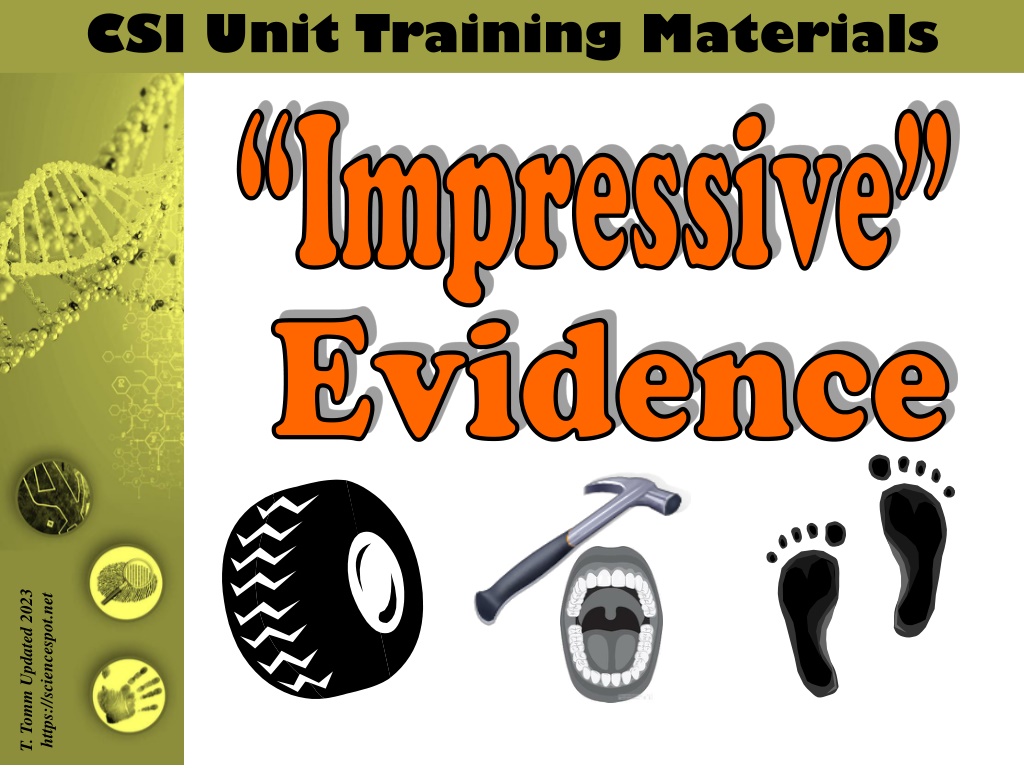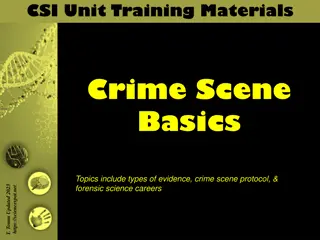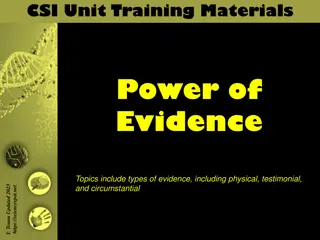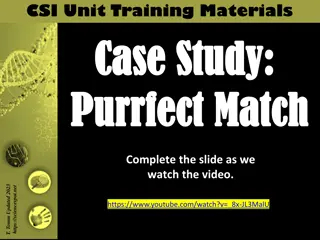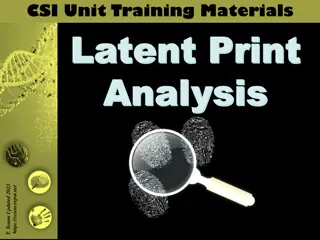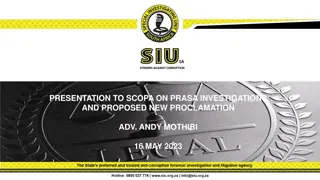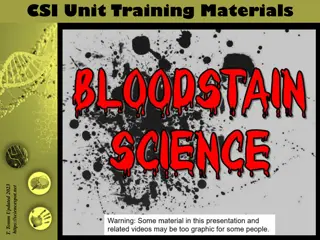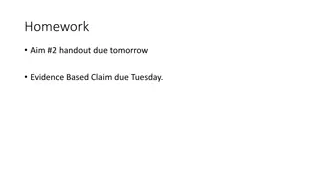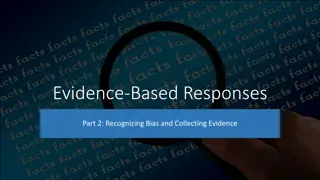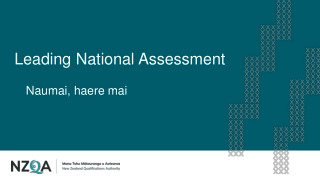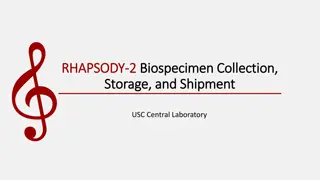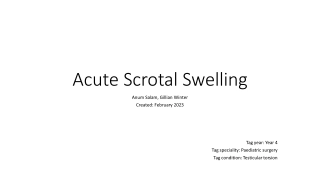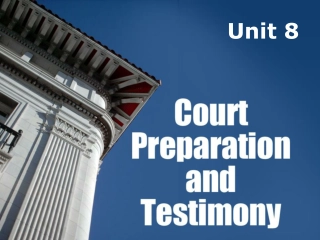Understanding Impression Evidence Collection in Forensic Investigations
Impression evidence plays a crucial role in forensic investigations, with examples including shoeprints, tool marks, tire tracks, bite marks, and riffling marks on bullets. The quality of impressions depends on various factors like the object making the impression, surface conditions, and the material of the surface. Collection methods vary between 2-dimensional photography and tape lifting to 3-dimensional casting using dental cement. Class and individual characteristics help differentiate between group-related and specific evidence, aiding investigators in solving cases.
Download Presentation
Please find below an Image/Link to download the presentation.
The content on the website is provided AS IS for your information and personal use only. It may not be sold, licensed, or shared on other websites without obtaining consent from the author. Download presentation by click this link. If you encounter any issues during the download, it is possible that the publisher has removed the file from their server.
Presentation Transcript
CSI Unit Training Materials Impressive Evidence Complete the slide as we watch the video. You will use the information to determine which view (investigators or detectives) you believe to be the most reliable. T. Tomm Updated 2023 https://sciencespot.net
What is impression evidence? IMPRESSION EVIDENCE can be defined as OBJECTS or MATERIALS that have retained the characteristics of other objects through direct CONTACT. SHOEPRINTS, TOOL MARKS, TIRE TRACKS, BITE MARKS, and RIFFLING marks on a bullet are several examples of impression evidence. The QUALITY of the impression depends on: The OBJECT making the impression The HARDNESS of thesurface conditions, and What type of MATERIAL makes up the surface (soil, mud, dust, concrete, grass, skin, etc.) Images: http://upload.wikimedia.org/wikipedia/commons/archive/6/61/20070917141644!Shoeprint(forensic).jpg and http://www.topmark.co.nz/images/content/tmpics01/gallery-s/SilipressionTeethMold.jpg
How is impression evidence collected? 2-Dimensional (2D): Documented using photography to show TWO dimensions (length & width or width & height) Rulers may also be used to document exact dimensions. Impressions may be dusted with powder to be photographed or lifted with tape. They may also be collected using an electrostatic dust lifting process. Shoeprint: http://www.forensicsciencesimplified.org/fwtt/how.html
3-Dimensional (3D): Documents THREE dimensions (length, width, & height/depth) of a piece of evidence Casts are made to show depth, which involves using dental cement (or a similar substance) to preserve the dimensional characteristics of the print. Evidence may also be photographed with rulers or other objects to document dimensions Tire Track: https://www.youtube.com/watch?v=dhkSlJadfPs Shoeprint: http://www.forensicsciencesimplified.org/fwtt/how.html Images: http://www.evidentcrimescene.com/cata/cast/dscasting.html
Class vs. Individual Characteristics CLASS material belongs. Characteristic that shows the class or group a Examples: Tire tread pattern matches to a brand/type of tire Teeth or bite marks matches to a specific species of animal Paint chip from a tool may help us identify the manufacturer of the tool Footprint Evidence INDIVIDUAL specific item or person. Characteristics that match of evidence to ONE Examples: Wear pattern on a shoe print matches a suspect s shoe. Bite mark shows specific locations of teeth that can be matched to a suspect s dental profile Break in the end of a screwdriver matches a spot in the wood where it was used to pry open a door
Directions: Use what you learned from the previous slide to identify each example as either C (class) or I (individual). ? ____ Wear pattern on a shoe print matches a suspect s shoe (& his/her walking pattern) ? ____ Paint chip from a tool matches the type of red paint used on Tools R Us tools. ? ____ Tire tread pattern matches patterns used on a Hoosier 4- Ply Super Turf tire. ? ____ Broken corner on a screwdriver matches a mark left on a wooden doorway at a crime scene ? ? ____ Teeth or bite marks matches to a specific breed of dog. ____ Bite mark shows specific locations of teeth that can be matched to a suspect s dental profile.
Identify each example as either C (class) or I (individual). I ____ Wear pattern on a shoe print matches a suspect s shoe (& his/her walking pattern) C ____ Paint chip from a tool matches the type of red paint used on Tools R Us tools. C ____ Tire tread pattern matches patterns used on a Hoosier 4-Ply Super Turf tire. I ____ Broken corner on a screwdriver matches a mark left on a wooden doorway at a crime scene C I ____ Teeth or bite marks matches to a specific breed of dog. ____ Bite mark shows specific locations of teeth that can be matched to a suspect s dental profile.
Part B: Bite Mark Evidence WHAT CLUES CAN WE GET FROM A BITE MARK? Bite Mark Evidence Video TYPE of bite mark (human or animal) TEETH characteristics(position, dental work , wear patterns, etc.) TIME SINCE BITE The color of the area helps to estimate how long ago the bite occurred (old or recent bite) DNA - Swab for saliva or blood for DNA testing. LOCATION - Marks can be left on a victim s skin or other objects, such as Styrofoam cups, gum, or foods.
A closer look at bite mark evidence Make an Impression Maxilla 1 Label one side MAXILLA (top jaw) and the other MANDIBLE (lower jaw). 2 - Fold the Styrofoam plate in half. Width 3 Gently bite down on the plate to leave your bite mark impression. Depth 4 - Place a sheet of plastic film over the impression and use a permanent marker to recreate the pattern to match that of your bite mark. Mandible Time to create some evidence http://forensicfact.files.wordpress.com/2008/05/cast_negative_resized_copy.jpg
Maxilla Analyze your bite mark and compare with your group. How does the width of your bite mark compare to the depth? Width Do you have the same number of individual tooth impressions as your group mates? Depth Mandible What other details do you observe that would make it easy to identify as your bite mark? http://forensicfact.files.wordpress.com/2008/05/cast_negative_resized_copy.jpg
Answer the questions on your notes. What CLASS characteristics do you see in your bite mark? Possible answers would include the different types of human teeth (incisors, canines, molars) and approximate age (if molar impressions are present). What INDIVIDUAL characteristics do you see in your bite mark? List 3 characteristics. Possible answers would include missing teeth (baby teeth or other reasons), angles/slanted impressions, marks from braces, width & depth of bite mark, and tooth damage (chips, broken teeth, etc.) Click to reveal possible answers http://forensicfact.files.wordpress.com/2008/05/cast_negative_resized_copy.jpg
#2 - Bite Mark Challenge - Follow your teachers directions to test each material. Complete the chart with your quality rating and observations. Quality 1 = Poor to 5 = Excellent Candy Quality Observations Orange Slice Tootsie Roll Airhead Swedish Fish Circus Peanut What materials worked the best? Why? What else could we use? NOTE: As with any lab involving food, be aware of any food allergies that may be a concern with your students.
Part C: Tire Track Evidence Tire tracks are important in forensic investigations and are usually found in road accident scenes or may provide clues at crime scenes. Investigators may make ink prints of a tire or plaster casts of a track. They will also take photographs that can later be used to prove a match. Features to analyze: Tread pattern and size (width & depth) can help investigators identify the type of vehicle that left them Use tire databases to determine the brand and model of the tire that left the impression. Unique characteristics due to the wear pattern, damage, or material defects to help match it to a specific vehicle Images: http://www.suite101.com/view_image.cfm/454216, http://www.ronsmithandassociates.com/FWTTS.htm.
Directions: Complete the notes as you watch the video. Video Link: https://edpuzzle.com/media/5ae084f8cf5572411ed5ca8d
United Streaming: The Value of Evidence Click to reveal answers Part A: Complete this worksheet as you watch the video. PHYSICAL 1. The job of the Forensic Science Unit is to collect ____________ evidence. PHOTOGRAPHED 2. To document a tire track, it is first ______________________ and then ___________ are made using dental cement that is poured into a metal form. CASTS LIGHT 3. Investigators use a high-powered _____________ to trace the path to the victim. The light shines at ____________________ that cause materials to fluoresce and ________________ goggles help make evidence stand out sharply. WAVELENGTHS ORANGE 4. Evidence that is collected at a crime scene is analyzed by a ___________, who goes through the debris that is collected at a crime scene. CHEMIST (Or other specialists) CARPET 5. ____________ fibers are valuable clues because they can link suspects to a specific location.
6. The tire track expert studies the photographs taken at the crime scene to examine the tread _____________ to determine what kind of vehicle uses that kind of a tire. PATTERNS 7. Tire treads are made up of geometric shapes called __________. The key to tire identification PITCHES is to match DIFFERENCES _________________ in pitches. They also examine tiny cuts on the surface called _______ that were molded into the tire by small metal teeth. SIPES EVIDENCE 8. The final pieces of _______________ needed for an airtight case was obtained by investigators offering a dog bathing service. During the bath, investigators gathered some dog _________ and also got carpet _________ from the living room, which matched those found at the crime scenes. HAIRS FIBERS
Tire Track Challenge Forensic Science Activity http://pro.corbis.com/images/CB001940.jpg?size=572&uid={D27A89DF-00BB-4028-AA57-7A908AF0511D} T. Trimpe 2007 http://sciencespot.net
Your group will need to document the tread patterns for each vehicle. Tire Track Lab Teacher Note: For this activity I raided my son s Hot Step 1: Get a large piece of white paper from your teacher. You will also need a pen or pencil. Step 2: Fold the paper into thirds as demonstrated by your teacher. Step 3: Divide each column into 6 spaces for a total of 18 spaces. Step 4: At each station, gently roll each car over the ink pad several times to cover all the sides of the tires. Step 5: Gently roll each car on the white paper for a length of 5-6 and label the tracks with the correct letter. Caution: You will want to apply enough pressure to get a good impression, but not too hard that you cause damage to the vehicle, its tires, or the ink pad. Step 6: Roll each car on a piece of paper towel to remove excess ink and then wait quietly for the teacher to say to rotate before you go to the next station.
Step 7: Cut apart the tread samples so you have 18 strips. Organize into at least 3 different groups. Step 8: Analyze the tire tracks to identify unique characteristics and use a highlighter to mark each characteristic you find. Features to analyze: Tread pattern Width & depth of the tread pattern Unique characteristics due to the wear pattern, damage, or defects Answer the question on your notes based on the types of features you observed highlighted.
Tire Track Challenge Work with your partner to identify the 8 tracks shown on the challenge worksheet. Compare the tracks you made earlier and match them to the suspect tracks on the worksheet. Once you have identified all the cars, have your answers checked by your teacher. Keep trying until you have them all correct! Ready? Set? GO!
REAL DEAL CHALLENGE How many of the real tire tracks can you identify? (1) Examine the samples located around the room. NOTE: You are not allowed to move them! (2) Examine the ink prints on the back cabinets. (3) Write down the numbers that match each ink print in the box on your worksheet. (4) You will have 10 minutes to match as many as you can before we go over the answers! Teacher Note: I obtained samples of real tire treads from a local tire shop. They labeled the back with the brand of tire. I used a paint roller and ink to make prints. The prints were laminated and displayed around the classroom. Students had time to examine the real tires and try to match it to a print.
